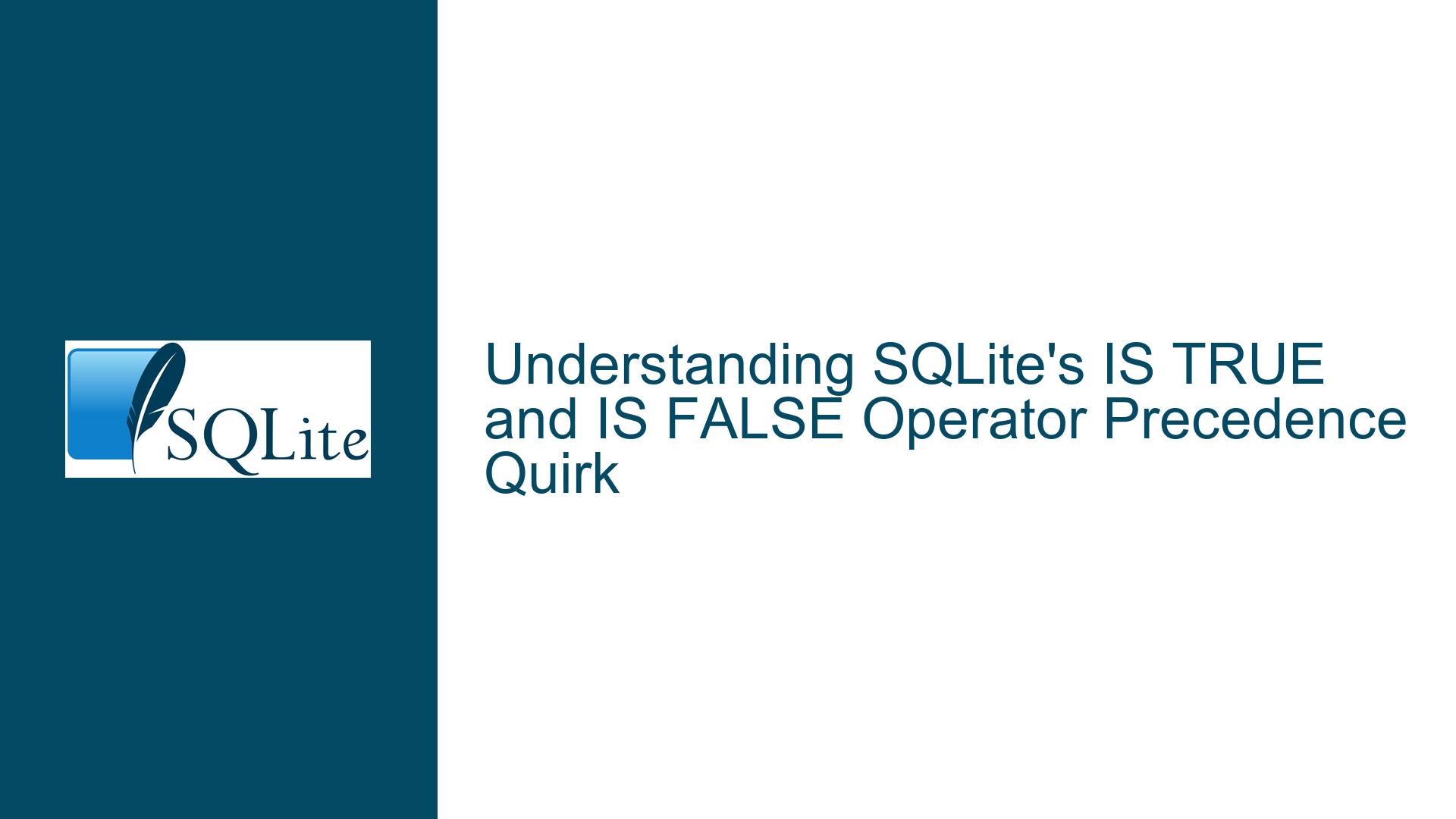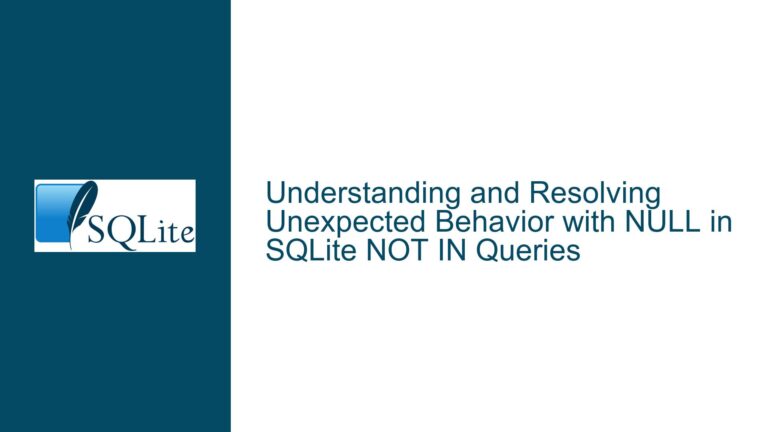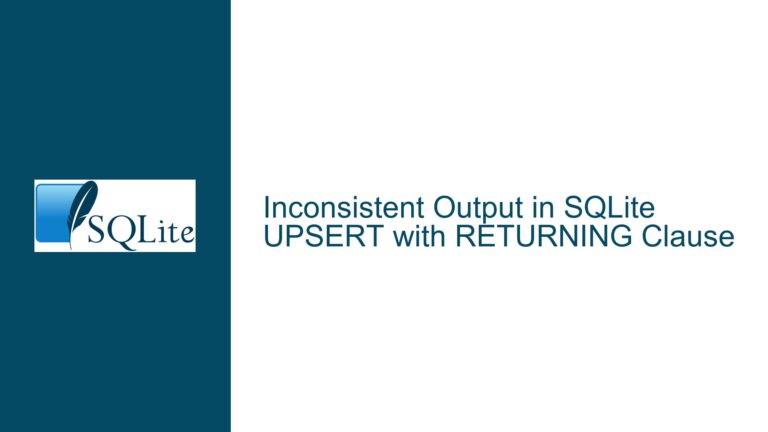SQLite’s IS TRUE and IS FALSE Operator Precedence Quirk
Issue Overview: SQLite’s IS TRUE and IS FALSE Operator Precedence Behavior
The core issue revolves around the behavior of the IS TRUE and IS FALSE constructs in SQLite, particularly in relation to operator precedence and their implementation as special cases of the IS operator. Unlike PostgreSQL, where IS TRUE and IS FALSE are treated as unary postfix operators with their own precedence rules, SQLite implements these constructs as special cases of the binary IS operator. This leads to differences in how expressions involving these constructs are evaluated, especially when combined with other operators like the concatenation operator ||.
In SQLite, the expression null is true || 'x' is evaluated as null is (true || 'x'), which results in 0 (false) because true || 'x' evaluates to '1x', and null is '1x' is false. In contrast, PostgreSQL evaluates null is true || 'x' as (null is true) || 'x', which results in falsex because null is true is false, and concatenating false with 'x' yields falsex.
This discrepancy arises because SQLite does not treat IS TRUE and IS FALSE as standalone unary postfix operators but rather as special cases of the IS operator. This implementation detail affects how these constructs interact with other operators, leading to unexpected results in certain edge cases.
Possible Causes: Why SQLite’s IS TRUE and IS FALSE Behavior Differs from PostgreSQL
The root cause of this behavior lies in SQLite’s implementation of the IS operator and its handling of TRUE and FALSE as right-hand operands. In SQLite, IS TRUE and IS FALSE are not treated as independent unary postfix operators but are instead implemented as special cases of the binary IS operator. This means that the IS operator in SQLite checks whether its right-hand operand is TRUE or FALSE and then applies the corresponding boolean logic.
This implementation choice has several implications:
Operator Precedence: In SQLite, the
ISoperator has a lower precedence than the concatenation operator||. As a result, expressions likenull is true || 'x'are evaluated asnull is (true || 'x')rather than(null is true) || 'x'. This differs from PostgreSQL, whereIS TRUEandIS FALSEare treated as unary operators with higher precedence, leading to different evaluation orders.Expression Tree Construction: In SQLite, the expression tree for
IS TRUEandIS FALSEis constructed such that theISoperator is always binary, withTRUEorFALSEas its right-hand operand. This means that expressions like2 IS TRUEand2 IS (TRUE)generate the same expression tree, whereas2 IS +TRUEgenerates a different tree because+TRUEis treated as a separate expression.Semantic Differences: SQLite’s implementation of
IS TRUEandIS FALSEas special cases of theISoperator leads to semantic differences compared to other databases like PostgreSQL. For example, in SQLite,null is trueevaluates to0(false), whereas in PostgreSQL, it evaluates toNULL. This is because SQLite’sIS TRUEconstruct is effectively shorthand forx != 0, which normalizesNULLto0.Documentation Clarity: The SQLite documentation initially described
IS TRUEandIS FALSEas forming new unary postfix operators, which was misleading. This description has since been corrected to reflect the actual implementation, whereIS TRUEandIS FALSEare special cases of theISoperator rather than independent unary operators.
Troubleshooting Steps, Solutions & Fixes: Addressing SQLite’s IS TRUE and IS FALSE Quirks
To address the issues arising from SQLite’s implementation of IS TRUE and IS FALSE, consider the following troubleshooting steps, solutions, and fixes:
Understand SQLite’s Operator Precedence: When working with
IS TRUEandIS FALSEin SQLite, it is crucial to understand that these constructs are not unary operators but special cases of theISoperator. This means that their precedence is determined by theISoperator, which has lower precedence than operators like||. To avoid unexpected results, use parentheses to explicitly specify the evaluation order. For example, instead of writingnull is true || 'x', write(null is true) || 'x'.Use Alternative Constructs: If the behavior of
IS TRUEandIS FALSEin SQLite is problematic for your use case, consider using alternative constructs that provide the desired semantics. For example, instead ofx IS TRUE, usex != 0, and instead ofx IS FALSE, usex == 0. These constructs are more explicit and avoid the quirks associated withIS TRUEandIS FALSE.Leverage SQLite’s ISNULL Operator: SQLite provides an
ISNULLoperator that can be used to achieve similar results toIS TRUEandIS FALSEin certain cases. For example,true isnull || 'X'evaluates to0X, which may be closer to the desired behavior in some scenarios. However, note thatISNULLis not a direct replacement forIS TRUEandIS FALSEand should be used with caution.Update Documentation References: Ensure that you are referencing the most up-to-date SQLite documentation, which has been clarified to accurately describe the behavior of
IS TRUEandIS FALSE. The updated documentation emphasizes that these constructs are special cases of theISoperator rather than independent unary operators, which helps set the correct expectations for their behavior.Consider Database-Specific Behavior: If your application needs to work across multiple databases, be aware of the differences in how
IS TRUEandIS FALSEare implemented. For example, PostgreSQL treats these constructs as unary operators with higher precedence, leading to different evaluation orders compared to SQLite. To ensure consistent behavior, consider using database-specific code paths or abstraction layers that handle these differences.Evaluate the Impact on Existing Code: If you have existing code that relies on the behavior of
IS TRUEandIS FALSEin SQLite, evaluate whether this behavior is causing issues. In particular, check for expressions where the evaluation order might be affected by SQLite’s operator precedence rules. If necessary, refactor these expressions to use parentheses or alternative constructs that provide the desired semantics.Engage with the SQLite Community: If you encounter issues with
IS TRUEandIS FALSEthat are not addressed by the above steps, consider engaging with the SQLite community for further guidance. The SQLite forum and mailing lists are valuable resources for discussing edge cases and obtaining advice from experienced users and developers.Monitor for Future Changes: SQLite is actively maintained, and its behavior may evolve over time. Keep an eye on future releases and documentation updates to stay informed about any changes related to
IS TRUEandIS FALSE. If the SQLite team decides to adjust the implementation or precedence of these constructs, be prepared to update your code accordingly.
By following these troubleshooting steps and solutions, you can effectively address the quirks associated with SQLite’s implementation of IS TRUE and IS FALSE and ensure that your queries behave as expected. While these constructs provide a convenient shorthand for boolean logic, understanding their nuances is essential for avoiding pitfalls and achieving consistent results across different database systems.






